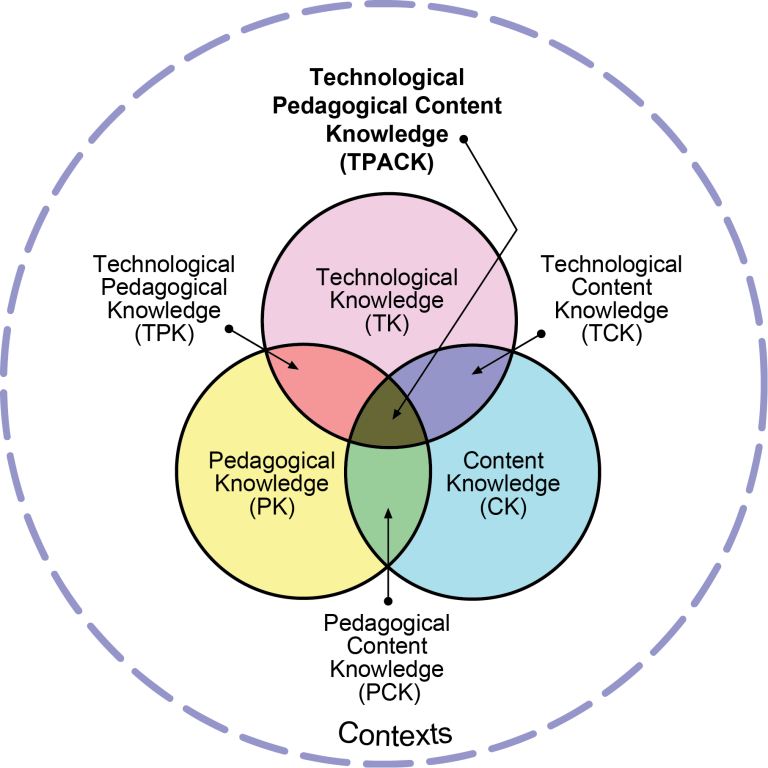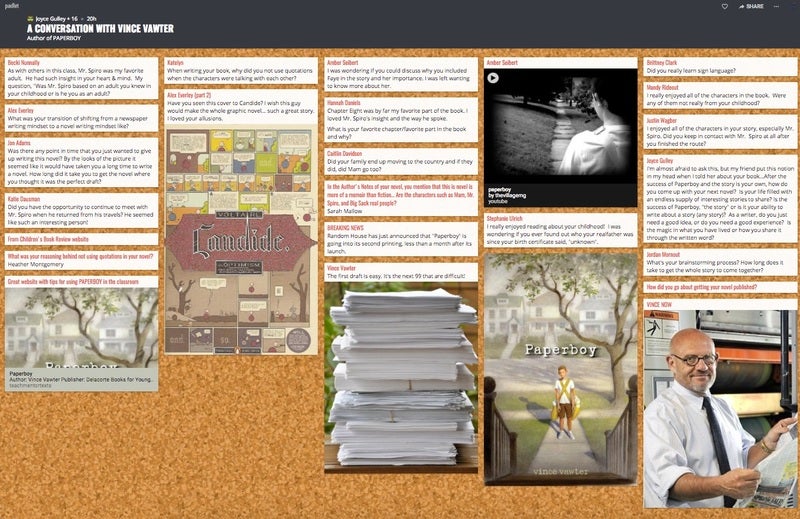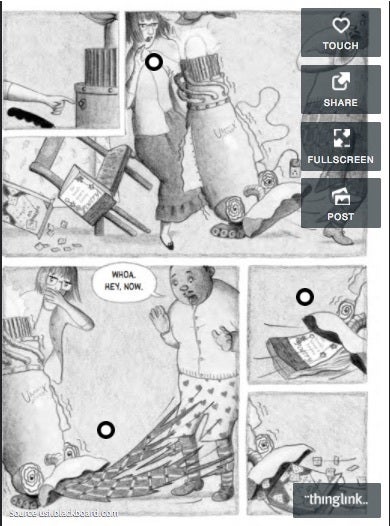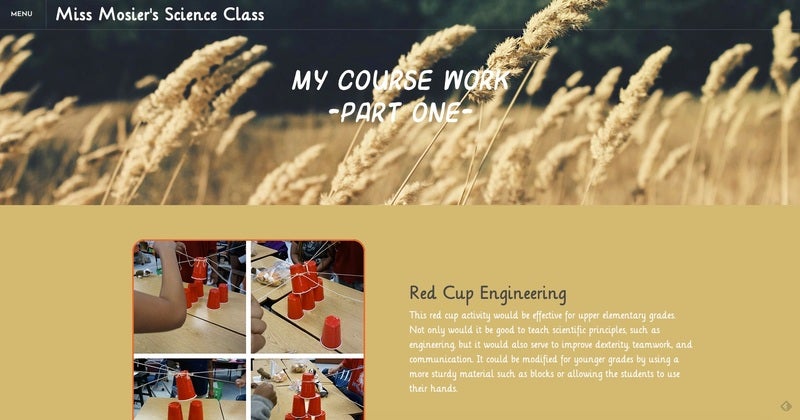Using Web 2.0 tools to engage learners
Contents
Introduction
Web 2.0 tools are free digital programs that can be used for creating and sharing student-generated projects and products. They are interactive, multi-purpose, easy-to-use digital platforms that encourage students to collaborate with each other or create and share individualized response products.
Web 2.0 tools provide engaging ways students can interact with, and most importantly, learn from course material. They are particularly helpful when aligned to teaching and assessment exercises meant to increase student engagement, require students to summarize information, or verbalize insight into their conceptual understanding through means other than traditional writing exercises.
Web 2.0 tools also provide students an opportunity to interact with others as they share their knowledge. Students can collaborate with classmates to create response products, or they can share completed products with peers in their class, students in other sections, or other learners around the world. Web 2.0 tools create opportunities for students to share what they are learning with a wider audience.
This video provides a brief introduction to Web 2.0 tools:
Objectives
After completing this module, you will be able to:
- List examples of Web 2.0 tools and discuss their applicability to the college classroom.
- Evaluate a potential technology tool for applicability to your learning objectives, class content, and student population to determine if it is a tool you will incorporate in your course materials and/or assignments.
UDL Alignment
This module aligns with: Provide Multiple Means of Action and Expression, Principle 1; Provide Multiple Means of Action and Expression, Principle 2; and Module Alignment with Provide Multiple Means of Engagement, Principle 3.
Module Alignment with Provide Multiple Means of Representation
While instructors may decide the core idea of what is to be shared, it is students that ultimately decide, and customize, how they represent details of the material. Students increase their time on task and fluency with content and technology as they interact with content and recreate connections to it. When students struggle how to express information, they are forced to face their (mis)understanding, which helps them better learn the material.
Module Alignment with Provide Multiple Means of Action and Expression
Students use (and improve their skill levels with) technology devices to capture their own words, images, sounds, and work as they express acquired knowledge. By expressing conceptual understanding through their own framework they make their own meaning. Instructors can then verify correct application to students’ learning frameworks. For specific students (e.g., language deficient students) tools can serve as methods to share written or spoken understanding of concepts when they haven’t yet mastered subject specific vocabulary.
Module Alignment with Provide Multiple Means of Engagement
Using Web tools increases students’ autonomy and engagement with content as they identify what they know, value, and find interesting about it. Because students see and hear themselves when working with Web tools they often invest more time and energy, while simultaneously utilizing multiple modalities, to engage with content.
Instructional Practice
What are Web 2.0 tools?
Web 2.0 tools can very broadly be defined as end-user applications that require dynamic interaction, social networking, or user interfacing between people and information. They almost always have accompanying websites and associated apps for smart devices. In a Web 2.0 environment users decide how they want to use, interact with, and create information. This contrasts with earlier Web 1.0 environments where one simply read static information on the Web (Morrison & Lowther, 2005).
In addition, users have the ability to generate and manipulate content from multiple locations in a Web 2.0 environment. Users can add images, videos, or links to other media content. Students have unlimited opportunities to individualize the content they embed in their products, and the ease of use of these tools encourages student creativity. Unlike traditional pen and paper type responses, students are not limited by their own artistic abilities, page-length, or word count limits. Students will often go beyond the basic expectations of an assignment because these tools facilitate students’ creative processes.
Familiar examples of Web 2.0 sites and tools include wikis and blogs (PBworks and WordPress), social networking sites (Facebook and Twitter), image and video hosting sites (Flicker and YouTube), and applications to generate Web content for education, business, and social purposes (Wikipedia, Weebly, and Instagram). It is important for teachers to remember that the magic is not necessarily in the tool itself; teachers must first consider their objectives for the lesson as well as the purpose of the student response project. The right tool can help students synthesize their learning, engage more deeply with the content of a lesson, and interact with other learners in more meaningful ways than traditional response projects or assignments.
Benefits of Web 2.0 tools
One of the benefits of Web 2.0 tools is their ease of use. Most students find these tools to be intuitive and user-friendly. Because of this, there is little time wasted in learning how to use the programs. The tools facilitate interactive learning and innovative responses to assignments and assessments. Students see their ideas take shape quickly, and they are rewarded with professional-looking results. It is also easy to edit the projects as they are being developed so students tend to take more risks during the creative process. This ease of use combined with the quality of the finished products increases students’ self-efficacy, and it motivates students to engage more earnestly and actively in the content of their responses.
Web 2.0 tools also can facilitate authentic interactions with content and with other learners. These tools offer students opportunities to solve real-world problems and to collaborate in meaningful ways with peers in face-to-face or online classrooms. Students have the freedom to customize their responses using multimedia or multiple modalities. Unlike a term paper or more traditional response project, no two projects look exactly alike. Students’ individual interpretations and representations of their conceptual understandings can easily be shared with others, thus increasing the learning opportunities for all.
Choosing and using a tool with students
The right Web 2.0 tool for the task is the one that matches the objectives of the lesson. The tool should not just be an “add-on,” but rather it should be a natural extension of the lesson that reinforces the skills or concepts taught. What do you want students to learn or to be able to do as a result of the lesson or unit of study, and what tool will help you achieve that goal?
Sample student work
Described below are four tools and a brief summary of how each was used by students in a learning or assessment exercise. These specific tools were chosen because of their versatility and the fact they have no cost to download and use. They all have a “pro” version for a nominal fee. The exception is VoiceThread and it was chosen because it is commonly supported by many campus across the United States or can be purchased by individual instructors for a relatively low fee.
Padlet. Padlet is a multipurpose tool acting as an electronic corkboard where students can post ideas, photos, images, videos, or documents. This digital corkboard is both versatile and easy to use. The user can control the privacy settings on the Padlet to allow others to add content or simply to view existing content. Viewers do not need an account to post comments, and the owner of the Padlet retains full control to moderate or delete comments. In the assignment displayed here, students created questions in advance of a Skype visit with a children’s book author. The link was shared with the author in advance so that he could see the types of questions students would be asking.
Examples connected to other disciplines: Padlet could be used in any content area classroom for bell-ringer activities or exit tickets at the end of class. Marketing students could use Padlet as a corkboard to post effective print ads or links to digital ads. Political science students could use Padlet as a place to collect campaign slogans and reflect on their significance.
Thinglink. This tool is useful for sharing visual information. The user uploads an anchoring image, such as a map, photograph, or drawing. The user then inserts “tags” which link to additional information such as definitions, maps, images, or other websites. In the example below, the student used images from a novel to illustrate vocabulary that is used in the book. The dark circles indicate where the viewer should click to access additional information.
Examples connected to other disciplines: Thinglink could be used as a getting acquainted activity; students could post pictures of their hobbies and interests and then share with classmates. Thinglink could be used as a tool for many different types of reports. For instance, when studying the lives of famous people in any discipline, upload an image of the subject and create links to this person’s accomplishments, noteworthy speeches, or historical events related to the subject. Similarly, Thinglink could also be used effectively with any type of mapping activity, such as identifying landforms or landmarks in a geographical location.
Weebly. Weebly is one tool in a family of tools that users use to create websites. Like many tools it offers a free and “pay for” version. Instructors and students can easily get what they need from the free version. Perhaps the most significant limitation is the inability to upload video with the free version. However, an easy work around is to upload videos to YouTube and connect the video to the Weebly site. One of the many useful features in Weebly’s setup includes the ability to design one’s website using a drag and drop tool bar. Examples of items that can be added include images, slideshows of images, text boxes, hyperlinked text, files, linked YouTube videos, maps, and linking Web elements containing embed codes. The image below links to a sample assignment with preservice elementary teachers. One of the course’s objectives is to provide an environment that models many of the teaching and assessment strategies future teachers can use in a classroom. Using their cell phones, students capture, and reflect on, these moments they build a website throughout the semester that includes their work, the strategies we model, and relay its connection to themselves and their future students. It, therefore, adheres to one of the more significant aspects of writing, learners should “write a little a lot” versus “write a lot a little.” That is, the more ongoing the writing the more students can remain engaged in processing and internalizing information. Additionally, if one is using other Web tools those products can be linked or embedded to their website.
Examples connected to other disciplines: Weebly can be used to showcase student work in any discipline. In art classes, students could create digital portfolios of their work showing pieces they have created over time or in different media. History students might use Weebly to analyze a specific event and its impact on society. Students in an English class could share their reflections on assigned or free choice reading selections.
VoiceThread. Voicethread is a free tool to use for presentation of material. It can be used by the instructor to record announcements or lectures, and it can be used by students for individual or group projects. Voicethread can be a static one-sided presentation, or a collaborative tool where multiple users interact around a topic, an image, a Powerpoint presentation or other media. Students can leave audio, video, typed, or drawn comments using a computer, tablet, or cell phone. Voicethread has a computer-based platform, as well as apps for iOS and Android devices. The following example is one student’s presentation on a children’s book illustrator. The assignment required students to research an illustrator’s life and work. The student created a PowerPoint and then uploaded it to Voicethread. The student then provided an audio narration to elaborate on the slides, as well as music to enhance the presentation. Voicethread allows for viewers to comment on the student’s work in both a private mode (viewable by the project creator) and a public mode (viewable by anyone with the link to the project). The creator of the project can moderate the public comments or delete them entirely. Many universities have Voicethread integrated with their campus-wide learning management system, such as Blackboard, so that the posting, sharing, and grading of projects is seamless.
Examples connected to other disciplines: Because of its interactive capabilities, Voicethread can be used in multiple disciplines, and it is especially helpful when students need to present their work and then receive feedback from classmates, the teacher, or anyone with whom the link is shared. For instance, students in a world language course could use Voicethread to practice their oral speaking skills. The instructor could then provide private comments to that student reinforcing correct pronunciation of vocabulary words. Science students could use Voicethread to create an oral report on any topic, and classmates could add written or oral comments reflecting on what they learned by listening to the report.
Limitations of Web 2.0 tools
While Web 2.0 tools offer many advantages for instructors and students alike, they are not the perfect solution for all educational challenges. The tool must actually enhance the learning process, not simply add unnecessary tasks for students to complete. If students can communicate their understanding of the learning objectives without technology, then a more traditional response assignment may suffice.
Instructors must also consider all of the steps in the process of using the tool. Does a particular tool work on all types of computers and tablets, or will students need to use a certain type of device? Does the tool require students to create their own account, or does the teacher create a class account for students to use? Does the tool work with the Learning Management System (such as Blackboard or Course Compass)? Is the tool accessible for students with disabilities? Does the tool protect students’ privacy?
Instructors must also consider the complexity of the tool to be used and how much time it will take to teach the tool itself. Students who are experienced with technology will access new tools with greater ease than students who are timid with technology. In face-to-face classes, instructors can demonstrate how to use the tools and be present to help students troubleshoot any problems that arise. In distance learning courses, this process may be more cumbersome. Instructors can make screen shot videos to show students the step-by-step procedures, but some students have a low tolerance for troubleshooting problems on their own.
There is also a danger of over-using these tools. Even the most novel and engaging tool can become passé if it is assigned too often or used unnecessarily. Web 2.0 tools have a better chance of sustaining student engagement if they are used judiciously and purposefully.
Learn More
Essentially, today’s college-aged students have been digital consumers since they were young children. They grew up playing and learning with technology on their gaming systems, computers, and ever-present digital devices. For them, the worlds of entertainment and education are blended. As teenagers they are spending more hours engaged with their digital devices than they are sleeping (Common Sense Media, 2016). A recent study highlights that they are also using digital devices in their personal lives, some are using it in their college coursework, and most desire to use them more in their college coursework (Pearson, 2015).
While learning in much of their P-12 learning experience has evolved to incorporate technology into learning and assessment, much of their university learning has failed to do so. One reason is because university-based education faces the challenge of conveying large amounts of information in a relatively short amount of time (traditionally about 45 clock hours over one semester). Traditional lecturing can be one effective means of accomplishing this. Yet, students’ previous educational worlds and students’ subsequent professional worlds have shifted to a paradigm of using technology in everyday experiences.
So, how can university professors bridge this gap? One answer lies in using everyday technology with which students are familiar (their phones or digital devices) in targeted ways that enhance, not deduce, the amount of time and quality interaction with content material. An outcome is a classroom that is rich in learning experiences designed for students (Niess, 2011).
It is important to note that one should only use technology when it enhances learning. The goal is not to keep students busy for the sake of doing something (Lux, Banger, & Whittier, 2011). Only when technology enhances learning can it be considered an asset to students and instructors. Therefore, instructors should ask themselves, “How is technology helping students learn better than a method not using technology.” If there is no answer then there is no need to use technology. Yet, if one can devise an experience that favorably answers the question then there are benefits to its use. Only two examples include an increased time spent on material outside of class and increased self-efficacy.
When technology is used with outside class readings that requires students to post responses, additional information related to the reading, interpretations of reading, etc. student arrive better prepared to study and analyze the material. The instructor also has a more focused idea of where the students are, or wish to go, in their learning. Learning with technology can also increase self-efficacy with the learning process because they spend more time with material. Studies have shown that self efficacy influences long term success even if it doesn’t translate to short term success academic achievement measured by test scores (Abbitt, 2011; Chai, Koh, & Tsai, 2010; Jamieson-Proctor, Finger, & Albion, 2010; Sadaf, Newby, & Ertmer, 2012).
Fortunately, there is a lesson design model to help us with this. It is the TPACK model and the most widely used model in designing lessons with technology. Technological Pedagogical Content Knowledge (TPACK) is a framework that connects how instructors should integrate pedagogy (strategies of teaching), content (the material to be taught and learned), and technology (what content or skills are needed to work with the content. The TPACK model is shown in Figure 1. Mishra and Koehler (2006) are credited with finalizing the TPACK the model by evolving Shulman’s Pedagogy and Content (PCK) only model (Shulman, 1986; Shulman, 1987). While some lesson might incorporate all three knowledge bases, it isn’t a requirement (Pumak, 2011).

The model implies that each knowledge bases impacts learning while they interact with one another (Abbitt, 2011; Chai, Koh, & Tsai, 2010; Jamieson-Proctor, Finger, & Albion, 2010). These interactions can be helpful or harmful. It can be helpful when instructors align specific pedagogical strategies based on the content to be learned (see the CASE Mnemonic Devices for Instruction module). It can be harmful when instructors incorporate an overly complicated technology exercise that results in students struggling with the technology at the expense of a focus on content. This is an example of how the inappropriate choice of one knowledge base comes at the expense of a second base.
Research into TPACK reveals that as instructors develop deeper understanding of one knowledge base they can with effort be much better at understanding the interaction with the remaining bases. And, as expected, the opposite is also true (Harris & Hofer, 2011; Pamuk, 2012). University professors with their deep content knowledge are ideal candidates to build lessons incorporating technology and pedagogical strategies to help students learn content. Teaching strategies (both with or without technology) need to be aligned to certain content. Instructors with deep content knowledge possess an ability to determine if, or how, specific Web tools can elicit learning in the concepts they are teaching. We conclude, by reminding the reader of the Focus Question,” How is technology helping students learn better than a method not using technology.” Relatively easy to implement Web 2.0 increases the chance at successful alignment, content learning, student engagement, and self-efficacy with material and the learning process.
References & Resources
Abbitt, J. T. (2011). An investigation of the relationship between self-efficacy beliefs about technology integration and technological pedagogical content knowledge (tpack) among preservice teachers. Journal Of Digital Learning In Teacher Education, 27(4), 134-143.
Chai, C., Koh, J., & Tsai, C. (2010). Facilitating preservice teachers’ development of technological, pedagogical, and content knowledge (TPACK), Educational Technology & Society, 13(4), 63-73.
Common Sense Media (2015). THE COMMON SENSE CENSUS: MEDIA USE BY TWEENS AND TEENS. https://www.commonsensemedia.org/research/the-common-sense-census-media-use-by-tweens-and-teens (last accessed March 8, 2017).
Graham, C. R. (2011). Theoretical considerations for understanding technological pedagogical content knowledge (tpack). Computers & Education, 57(3), 1953-1960.
Harris, J. B., & Hofer, M. J. (2011). Technological pedagogical content knowledge (tpack) in action: A descriptive study of secondary teachers’ curriculum-based, technology-related instructional planning. Journal Of Research On Technology In Education, 43(3), 211-229.
Jamieson-Proctor, R., Finger, G., & Albion, P. (2010). Auditing the tk and tpackconfidence of pre-service teachers: Are they ready for the profession?. Australian Educational Computing, 25(1), 8-17.
Lux, N. J., Bangert, A. W., & Whittier, D. B. (2011). The development of an instrument to assess preservice teacher’s technological pedagogical content knowledge, Journal Of Educational Computing Research, 45(4), 415-431.
Mishra, P., & Koehler, M. J. (2006). Technological pedagogical content knowledge: A framework for teacher knowledge. Teachers College Record, 108(6), 1017-1054.
Morrison, G. R., & Lowther, D. (2005). Integrating computer technology into the classroom. Upper Saddle River, NJ: Pearson/Merrill/Prentice Hall.
Niess, M. L. (2011). Investigating tpack: Knowledge growth in teaching with technology. Journal Of Educational Computing Research, 44(3), 299-317.
Pamuk, S. S. (2012). Understanding preservice teachers’ technology use through tpack framework. Journal Of Computer Assisted Learning, 28(5), 425-439.
Pearson Education (2015). Student mobile device survey 2015 national report: College students. Boston MA: Pearson Education.
Prensky, M. (2001). Digital natives, digital immigrants. On the Horizon, 9(5), 1-6. Retrieved January 18, 2015, from http://marcprensky.com/articles-in-publications/
Sadaf, A., Newby, T. J., & Ertmer, P. A. (2012). Exploring pre-service teachers’ beliefs about using Web 2.0 technologies in K-12 classroom. Computers & Education, 59(3), 937-945.
Shulman, L. S. (1986). Those who understand: knowledge growth in teaching. Educational Researcher, 15(2), 4–14.
Shulman, L. S. (1987). Knowledge and teaching: Foundations of the new reform. Harvard Educational Review, 57(1), 1-22.
About the Author

Joyce Gulley
Joyce Gulley, Professor of Teacher Education, works with prospective and practicing teachers to identify high quality children’s literature to promote literacy and student engagement with text using technology. Her enthusiasm and student-centered teaching have led to numerous teaching awards and serving as a faculty teaching consultant across her campus.

Jeff Thomas
Jeff Thomas, Professor of Teacher Education, works with prospective and practicing elementary teachers to promote integration of inquiry-based science, children’s literature, and technology. His teaching focuses on providing learners experiences that use technology to organize, and make their own meaning, from material being explored.



